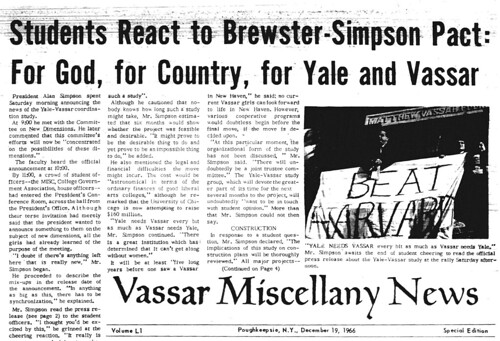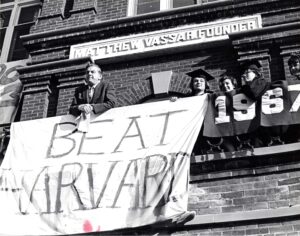The Vassar-Yale Study


In the 1960s, the elite colleges and universities of the East Coast were going through an identity crisis, finding that their single-sex traditions threatened to drive away the best students who wanted a coed undergraduate experience. Liberal arts colleges like Vassar found the lack of graduate programs and specialized facilities made it harder to attract the most ambitious students and faculty. Also, Vassar’s geographical position made some view the school as too isolated in its “ivory tower” as compared to universities and urban campuses that allowed students more community involvement and hands-on experience. Vassar found that its admittance rates compared to the other Seven Sisters schools fell in the 1950s and 60s, and with this in mind, the school began to study reforms.
When President Alan Simpson came to Vassar in 1964, he inherited a slow-moving Long-Range Planning Committee studying any and all possible reforms for the school. The Committee, with its broad focus and staff of volunteer faculty, did not move quickly on any of its proposals. Within two years, President Simpson created a new committee, the Presidential Committee on New Dimensions, to address the issues of reform more specifically and illustrate the new president’s commitment to conserving Vassar’s elite status in postsecondary education.
At the same time, in the fall of 1966, Vassar trustee Julius Stratton invited the Presidents of Yale and Vassar to dinner and said, “Kingman, you want to introduce women to Yale: Alan, you’re looking for new dimensions for Vassar, You two should have a lot to talk about.” Soon after, President Alan Simpson and President Kingman Brewster, Jr., of Yale met to discuss the possibility of a Vassar move to New Haven, and on December 11, 1966, President Simpson presented the possibility of a “royal marriage” to the Vassar College Executive Committee of Trustees. This was not the first discussion of a merger between the two schools: President Blanding had discussed a similar possibility with her Yale counterpart five years earlier. The 1966 plan proposed a study of the feasibility and desirability of a move to New Haven. Yale Corporation extended a formal invitation for the study to the Vassar trustees, and on December 14, they accepted. The invitation called for a Joint Committee made of representatives from both schools appointed by the respective presidents. This Committee broke the Vassar-Yale Study into three parts: a study of comparable co-ordinations at other universities, a comparison of the existing data available for each school, and a plan for academic coordination in the event of a merger.

From the start, the trustees and presidents knew certain important members of the Yale and Vassar communities would need prior notice of the study before a public statement. The implications of the study to the traditions of each school and the possibility of inaccurate rumors made confidentiality crucial to the study’s presentation to alums and faculty. Unfortunately, an article appeared in the New York Times only two days after the secretive trustees meeting; somehow the news leaked before either school even got the opportunity to warn its campus. President Simpson hurried to write a press release for December 18, but it was not enough to curb the rampant rumors. Faculty and alumnae from Vassar resented learning of the monumental study through the national press instead of the institutional networks. Unsubstantiated whispers of financial instability at Vassar, disintegration of the school’s elite status, and a conspiracy to benefit the two Presidents turned many against the study before the proposal had been properly explained.
For the next two months, President Simpson focused on damage control, but the initial suspicious reactions proved difficult to sway. Many alumnae opposed the proposed move from the beginning, citing their positive experiences in Poughkeepsie as proof of Vassar’s ability to continue alone. The faculty remained undecided but suspicious and worried about getting their voices heard. President Simpson addressed this fear by creating an ad-hoc Faculty Committee to aid the Joint Committee, but the faculty, still feeling under-represented, created their own version called the Elected Faculty Committee to “supplement” the President’s choice of representatives. For the duration of the study, the Dean in charge of the academic aspects had to consult with both committees on every issue. President Simpson also sought to soothe hurt feelings by reinvigorating the Committee on New Dimensions and allocating $25,000 to it for a study of alternatives to relocation, but that support paled in comparison to the $300,000 foundation grant funding the Vassar-Yale Study. While Yale assumed the study focused primarily on the feasibility of the move, the next ten months proved that at Vassar, the study would have to convince alumnae and faculty of its desirability.
One group on campus, however, did not need any convincing. The current students overwhelmingly supported the proposed move, responding to President Simpson’s announcement with cheers and rallies. A “For Sale” sign appeared on Davison House. Student questionnaires quickly showed that an overwhelming 90% of the current student population wanted a coed classroom experience and rejected the arguments in favor of single-sex education. They felt that men would add to the intellectual stimulation of a class, rather than intimidate women as some opponents of coeducation argued. The Miscellany News applauded the study’s formation as a solution to the woes of the current student body. Most appreciated, perhaps, by the students, was the possible end to the “weekend exodus” and “mixers” in search of men.

The second part of the study sought to provide the groundwork for those plans. Both schools put together data on admissions statistics, tuition and room and board costs, faculty pay scales, benefits, and leave policies, teaching loads, tenure policies, criteria for promotion and appointment, graduation requirements, class and lab use, etc. Vassar computed the value of its current facilities and the expected costs of building a full campus in New Haven. The proposed plant in New Haven would include a library, classrooms, dorms, and a student center all for Vassar use in addition to the existing New Haven campus. The proposed site for this new complex was on Prospect Street, where the Culinary Institute of America used to be located before it moved to its present home in Hyde Park, NY. While the site, in one Vassar representative’s assessment, was “more attractive than anticipated,” a factory nearby marred the horizon and a planned highway under or overpass threatened to cut the area off from the main Yale campus. Mini-bus service would have been required to get to the Yale Sterling Library, as it was a 25 minute walk from Prospect Street. However, the data-based side of the study did not address desirability, but rather presented facts and sought to provide a blueprint for creating a distinct place for Vassar in New Haven, separate from Yale, should the move take place.
The third part of the study proved the most controversial. Vassar faculty, already wary of the study and nervous about the discrepancy in funding between the Yale-Vassar Study and the Committee on New Dimensions, felt that the educational aspects of the move were underrepresented in the first phases of the study. More and more people began to see the Vassar-Yale merger an issue of educational philosophy rather than simply logistical concerns. In the spring of ’67, in between administering and grading exams for the end of the school year, two representatives of each Vassar Department met with two representatives from the corresponding Yale Department for two days to discuss the ways in which the two faculties would interact at on a Vassar-Yale campus. In those two days, discussions ranged from possible graduate teaching at Yale by Vassar professors, comparisons of course lists and structures, pedagogical responsibilities and beliefs, and even classroom facilities. Both sides then reported the results of the meeting to the study. Many of the reports spoke of mutual respect and compromises, but a few included caustic personal remarks about the other school’s department and had to be edited before final publication of the study. The meetings solidified the Vassar faculty’s opposition to the move, and many concluded in their reports that the move would not be in the best interests of their department.
The faculty opposition reflected in the third part of the study added fuel to the already aggressive dissent among the alumnae. Most of the women in the Alumnae Association thought Vassar ought to stay in Poughkeepsie and explore its opportunities at its historic home. Letters from angry alumnae compared the “squalor” of New Haven to the “pastoral tranquility” of Vassar’s Poughkeepsie location. Others pointed to what they perceived as insufficient attention to undergraduates at Yale and feared that a Vassar in New Haven would no longer continue its tradition of undergraduate excellence. Still others pointed to the Radcliffe-Harvard merger as proof that no “royal marriage” would allow autonomy for Vassar, despite all the best intentions. In October, 1967, an article by a Vassar alumnae entitled “How Dare They Do It” appeared in Time magazine. The article referenced rumors of a conspiracy between the two Presidents and claimed Vassar had been Yale’s second choice for a “dancing partner” after Connecticut College turned it down. President Brewster of Yale wrote a private letter to the Time editors denying the rumors, and both the Vassar and Yale student newspapers responded with scathing reviews of the article in their editorial columns. However, the article reflected the attitudes of a very vocal segment of the Vassar alumnae population who were so angry at the possibility of a merger that they threatened to pull their support, financial and otherwise, from the school should it move to New Haven.
By the end of October, the trustees, who would ultimately decide on the Vassar-Yale proposal, had unofficially rejected the offer. Proposals were made for cooperation short of relocation, but Yale wanted Vassar as its resident female college or not at all. On November 20, 1967, the Vassar Trustees rejected the Vassar-Yale plan and declared that instead that Vassar study the integration of men on its own campus, whether in a graduate or undergraduate institution built nearby for that purpose or in coeducation on the existing campus. Most of the work of the Vassar-Yale study, especially parts two and three, was inapplicable to the decisions facing Vassar after it decided to stay in Poughkeepsie. However, the data about other female college’s experiences with co-operative systems and the broader educational questions raised by the Vassar-Yale study both strongly influenced the college’s decisions in the next two years. Both the choice to implement coeducation from inside the college instead of creating a cooperative men’s college and the Comprehensive Plan that radically changed Vassar’s curriculum stemmed directly from discussions about Vassar’s possible place in New Haven. The Vassar-Yale Study, though defeated, forced the school to reevaluate its traditions and reform to reflect the new expectations of liberal arts colleges in the decades to come.
Related Articles
A History of the Curriculum 1865–1970s
Sources
“Coeducation File” assembled by Clyde Griffen, private collection of Elizabeth Daniels
Chesler, Ellen, Steven Weisman, and Michael Winger. “Vassar and Yale: The Whole Sad Story, The New Journal, vol. 1, no. 12 (April 28, 1968): 1-9, 16.
Daniels, Elizabeth and Griffen, Clyde. Full Steam Ahead in Poughkeepsie. Poughkeepsie: Vassar College, 2000.
Foote, Barbara A. “A Royal Marriage,” The Alumnae/I Quarterly, vol. 101, issue 1 (Winter 2004).
SRH, 2007